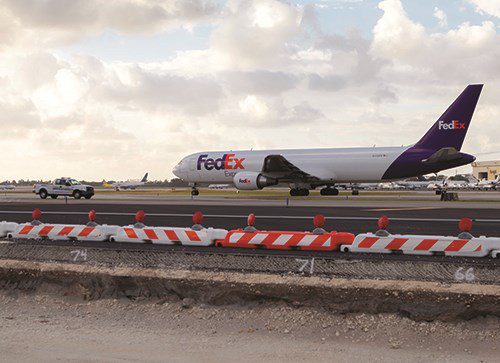Last summer was all about opportunity for Fort Lauderdale-Hollywood International Airport (FLL) in Florida. Its primary runway, 10L-28R, needed to close for 120 days while crews performed a complete rehabilitation; so management took the opportunity to improve several other airfield assets as well.
Last summer was all about opportunity for Fort Lauderdale-Hollywood International Airport (FLL) in Florida. Its primary runway, 10L-28R, needed to close for 120 days while crews performed a complete rehabilitation; so management took the opportunity to improve several other airfield assets as well.
 Airport officials note that the $95 million North Airfield Rehabilitation program sets the stage to support continued growth. The 18th busiest U.S. airport in total passenger traffic, FLL saw 35.9 million enplanements in 2018, up 10.6% vs. 2017. In fact, FLL has been the fastest-growing airport in the country for the last two years, according to FAA statistics.
Airport officials note that the $95 million North Airfield Rehabilitation program sets the stage to support continued growth. The 18th busiest U.S. airport in total passenger traffic, FLL saw 35.9 million enplanements in 2018, up 10.6% vs. 2017. In fact, FLL has been the fastest-growing airport in the country for the last two years, according to FAA statistics.
“We think we’ll continue growing, but not at the same rate,” says FLL Public Information Officer Gregory Meyer. “Things are slowing down a bit, but projections are we will continue to add additional service and passenger traffic.”
|
facts&figures Project: North Airfield Rehabilitation Location: Fort Lauderdale-Hollywood (FL) Int’l Airport Owner: Broward County Dept. of Aviation Cost: $95 million Scope: Complete rehabilitation of Runway 10L-28R, including replacement of 75-foot keel section with concrete, electrical, signage & drainage systems upgrades; FAA-funded taxiway enhancements & updated runway status lights Construction: General Asphalt Co. Engineer of Record: Kimley-Horn EMAS Beds: Safran Aerosystems (formerly known as ESCO) Security: Allied Universal Timeline…
Phase 2 Taxiway A Work:
Phase 3 Runway Closure:
Phase 4 Taxiway B & C Work: Final Completion: March 2020 |
Commonly known by staff as the “North Runway,” 10L-28R is 9,000 feet long, with portions dating back to 1943, when the airport was built as a Naval training base. Throughout the years, the county-owned airport performed regular maintenance to keep the runway in operational condition. This is the first time it performed such extensive improvements.
The asphalt runway had been on a 15-year rehab cycle, explains Gasser Douge, engineering unit supervisor for the Broward County Aviation Department. But when it approached the latest 15-year interval, airport officials decided to take a closer look at what repairs were needed.
A pavement condition index performed by Florida Department of Transportation’s Statewide Airfield Pavement Management Program indicated it was time for a rehabilitation.
Consulting firm Kimley-Horn, engineer of record for the project, provided FLL with several options for how to proceed; and airport officials created a decision matrix to rank them. Key factors were cost, duration of construction, benefits, maintenance and impact to operations.
One option was to continue the 15-cycle of milling and overlaying the asphalt runway. However, since asphalt requires more frequent rehabilitation than concrete, the impact to flight operations would be significant, given FLL’s increasing passenger volume.
Ultimately, the airport opted to replace the 75-foot-wide keel section with concrete, but mill and overlay the outboards with asphalt. Traffic growth heavily influenced the decision, notes Douge.
“Using concrete on the keel, we think we have a solution for about 30 years with good maintenance practices,” he explains.
Michael Carey, vice president of aviation at Kimley-Horn, notes that initial costs to mill and overlay asphalt are less than concrete; but when maintenance costs, impact of runway closures and total lifecycle are factored in, concrete is a better investment for FLL.
“It takes a client that has foresight to be willing to do something other than the cheapest and easiest short-term solution,” says Carey. “It will pay off when they’re not having to do major rehabilitation projects.”
Opportunity Knocks
Despite heavy traffic that continues to grow, FLL scheduled a 120-day runway closure for the runway rehab project. “We were able to carve out 120 days, and that allowed us the opportunity to do things that we normally would not have had from a time perspective,” says Carey. While a standard asphalt mill-and-overlay job could have been completed in less than 60 days, it would not have yielded the same benefits, he explains.
During the runway closure, the airport seized the opportunity to:
- upgrade airfield electrical systems and signage;
- convert airfield lighting from quartz to light emitting diode (LED) technology, a move designed to reduce energy and maintenance costs;
- replace engineered material arresting system (EMAS) beds at each runway end, which were installed in 2004 and had reached the end of their useful life;
- extend the east end of the Runway 10L-28R EMAS, in compliance with FAA requirements;
- change the profile of 10L-28R to address drainage issues caused by a former crosswind runway;
- address “hotspots” to help improve the airfield’s geometry and optimize runway use;
- realign several connecting taxiways that did not meet current FAA design standards; and
- relocate a terminal parking apron connector to meet FAA safety standards and minimize the potential for runway incursions.
“We took the opportunity to do our best toward bringing the runway up to full compliance with current standards,” Carey summarizes.
While the airport completed its runway and other airfield work, FAA upgraded its runway status lights and navigational aids.
Commitment to Neighbors
The 120-day closure of FLL’s primary runway meant that all traffic would need to use the South Runway. Further complicating matters, the airport has a voluntary interlocal agreement with the neighboring city of Dania Beach to restrict use of the South Runway between 10:30 p.m. and 6 a.m.

Because shifting traffic to the South Runway would impact Dania Beach, FLL amped up its community relations. “We had communications and outreach plans in place before they put the shovels in the ground for the project,” relates Meyer. “We went to greater lengths than we have in the past about construction projects.”
The strategy included weekly status calls among the public information office, consultant, internal project team and noise information office about the project’s progress, frequent meetings with elected officials, outreach efforts to homeowners associations and the business community, broad-base social media campaigns, news releases and media events.
 “The public outreach was extensive,” Douge says. “I think a communications plan is an essential component when you have this type of a project.”
“The public outreach was extensive,” Douge says. “I think a communications plan is an essential component when you have this type of a project.”
The team worked to keep internal and external stakeholders informed. Meyer notes that it was important to keep external stakeholders such as elected officials informed, because they would receive questions and complaints from constituents. “You have a very large audience with a project of this magnitude,” he reflects.
This aspect was also critical to the airport’s chief executive officer, Mark Gale. “He’s very sensitive to the concerns of the community,” explains Meyer. “While we don’t control the aircraft and flight patterns, there are things we can do to make sure the community is made aware of what’s happening, why and when. He [Gale] didn’t want the community to be surprised by this four-month closure.”
A bi-weekly newsletter with updates about the airfield project was posted on the airport’s website. It also regularly shared photos and video captured by drones to detail construction progress.
In addition, the public information office produced a four-minute video detailing the need for the project and what passengers should expect. It was shared via social media and on the airport’s website and YouTube channel.
“Knowledge is king,” emphasizes Carey. “The county did its best to keep people informed.”
Internally, the project team held weekly progress meetings. It also convened daily coordination meetings with contractors, FLL’s chief executive officer and chief operating officer, project manager, operations director, air traffic control tower chief, the airlines and airport tenants to keep everyone updated on the status of construction. “Coordination was a constant factor during the project—adjusting, reacting to the needs of the construction and also to the needs of the airport in general,” Douge relates.
Because the closure meant FLL was a single-runway airport for roughly four months, it was imperative for the operations team to develop a new plan to minimize operational impacts in the event of an aircraft incident. “We had a team on call that could be mobilized quickly to bring out the equipment we needed,” says Meyer.
Reality Check
Prior to putting the project out to bid, the airport held a pre-bid workshop with industry partners to ensure that the project’s scope was reasonable within the allotted timeframe. Once the design was at 75%, potential bidders were brought in to evaluate the plan for constructability and schedule. “We showed them what our intentions were, and we got some constructive feedback,” explains Carey. “We wanted to know that even if we had a perfect design, was 120 days a reasonable amount of time to build it?”
Airport officials were encouraged when prospective participants validated the plan and timetable. “That helped us solidify our plan to put this document out for construction,” Douge recalls.
 “The workshop was very valuable,” Carey agrees. “We tried to be reasonable to the contractor in giving something that could be accomplished within the timeframe, but still be aggressive so there was a sense of urgency.”
“The workshop was very valuable,” Carey agrees. “We tried to be reasonable to the contractor in giving something that could be accomplished within the timeframe, but still be aggressive so there was a sense of urgency.”
The contract for the 120-day project included incentives as well as liquidated damages, he adds.
Scheduling the project was tricky. As the 18th busiest commercial airport in the U.S., “slowest time of the year” is relative, notes Carey. Moreover, summer is hurricane season for the area. To make allowances, FLL included 16 days for possible weather delays in its agreement with General Asphalt Co., the construction contractor.
“You can never—especially in a subtropical environment like ours—underestimate the impact weather has on your project,” Carey emphasizes.

Hurricane Dorian did, in fact, cause the construction site to demobilize for four days. But FLL did not take a direct hit, and crews were able to resume work promptly.
The team constructed an onsite concrete batch plant to increase efficiency, maintain the aggressive schedule and minimize impact to the surrounding community. “We had direct access from the plant to the construction site, which was very helpful,” relates Douge. “The contractor didn’t have to purchase the concrete or have trucks on the roadways.”
Maintaining mobility for airport users was also an issue. Because tenants located on the north side of the airfield needed to maintain access to the south side, the project team could not fence off the worksite to make it a landside project for security purposes. The airport initially planned to maintain a single entry point for airside access, but it ultimately established three access gates when it became apparent how much traffic the project would require.
All access points were staffed by the airport’s contract security firm, Allied Universal. And Broward County Sheriff officers provided additional support when construction reached the east end of the runway, closer to the terminal.
After the North Runway opened on Oct. 1, there were nightly closures between midnight and 6 a.m. for 45 days to complete supporting taxiway work. Overall, the North Airfield Rehabilitation project is scheduled to wrap in March 2020.



